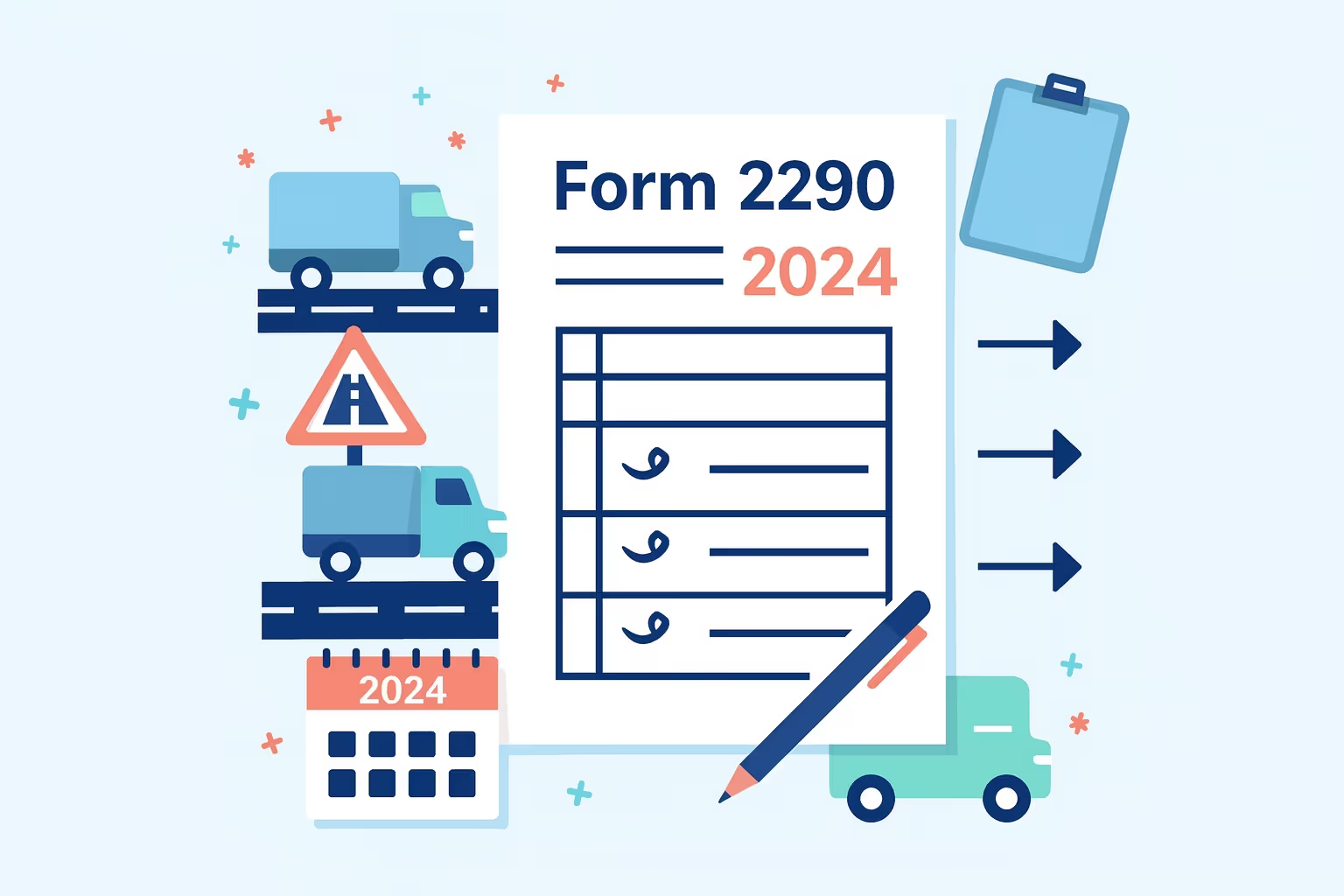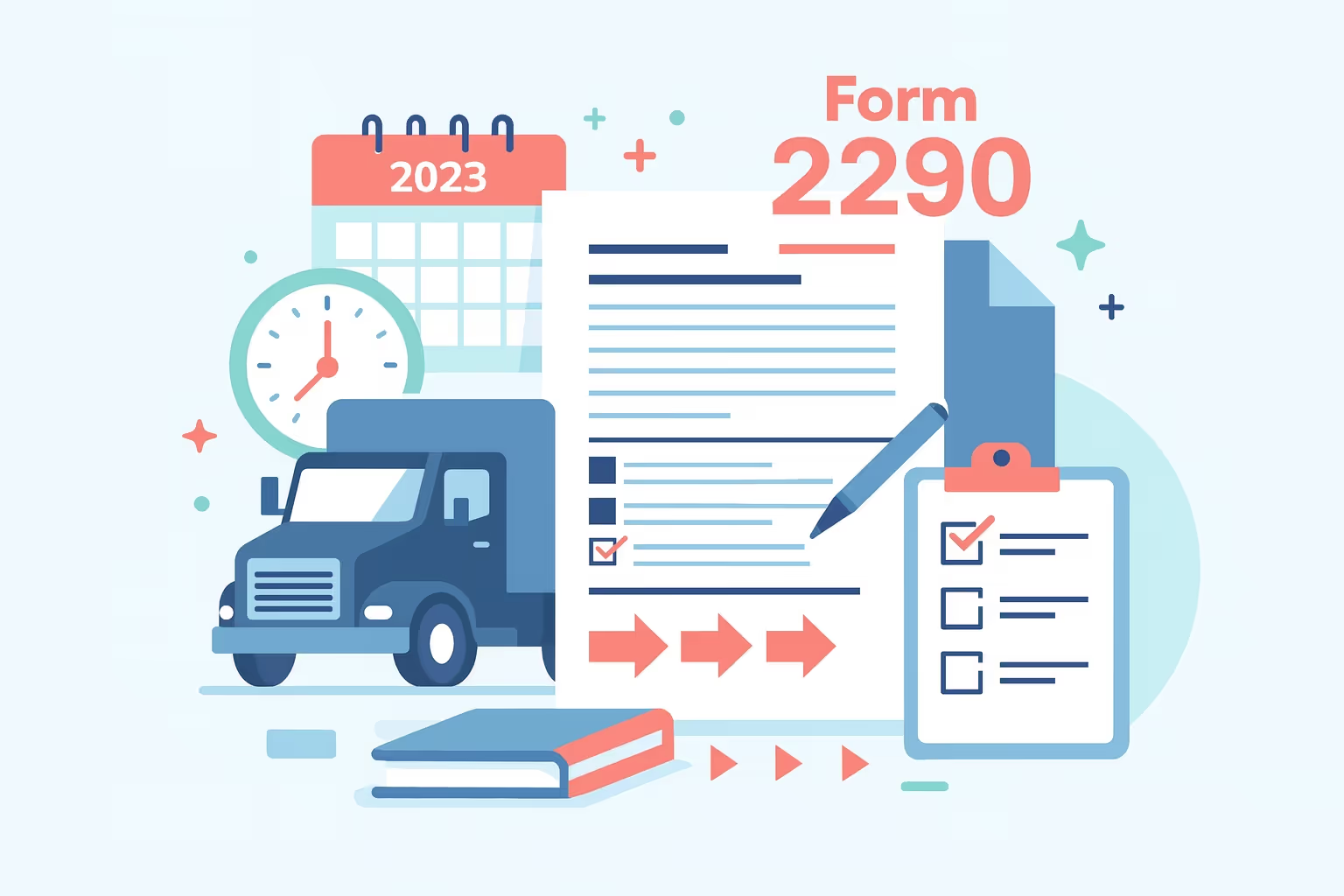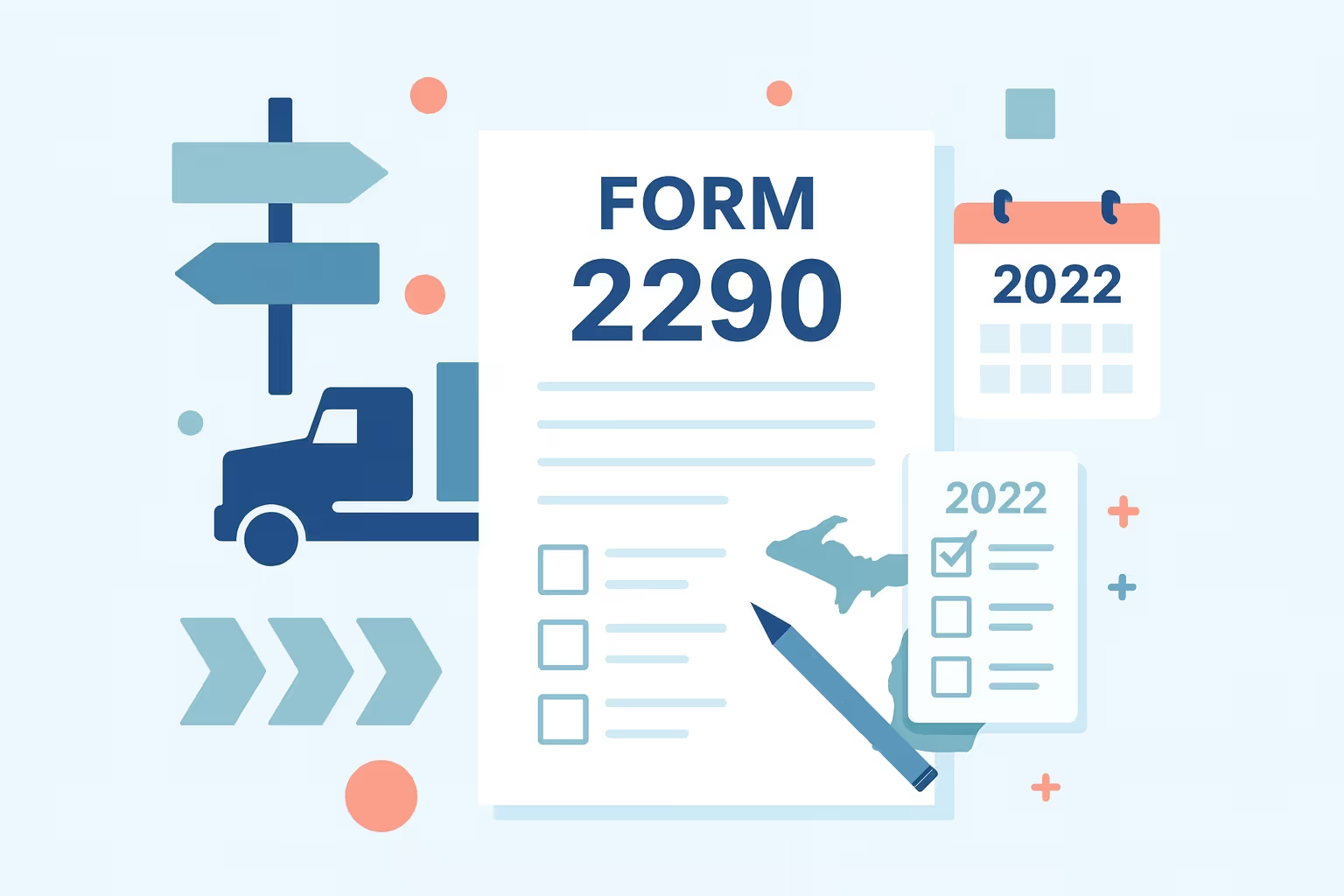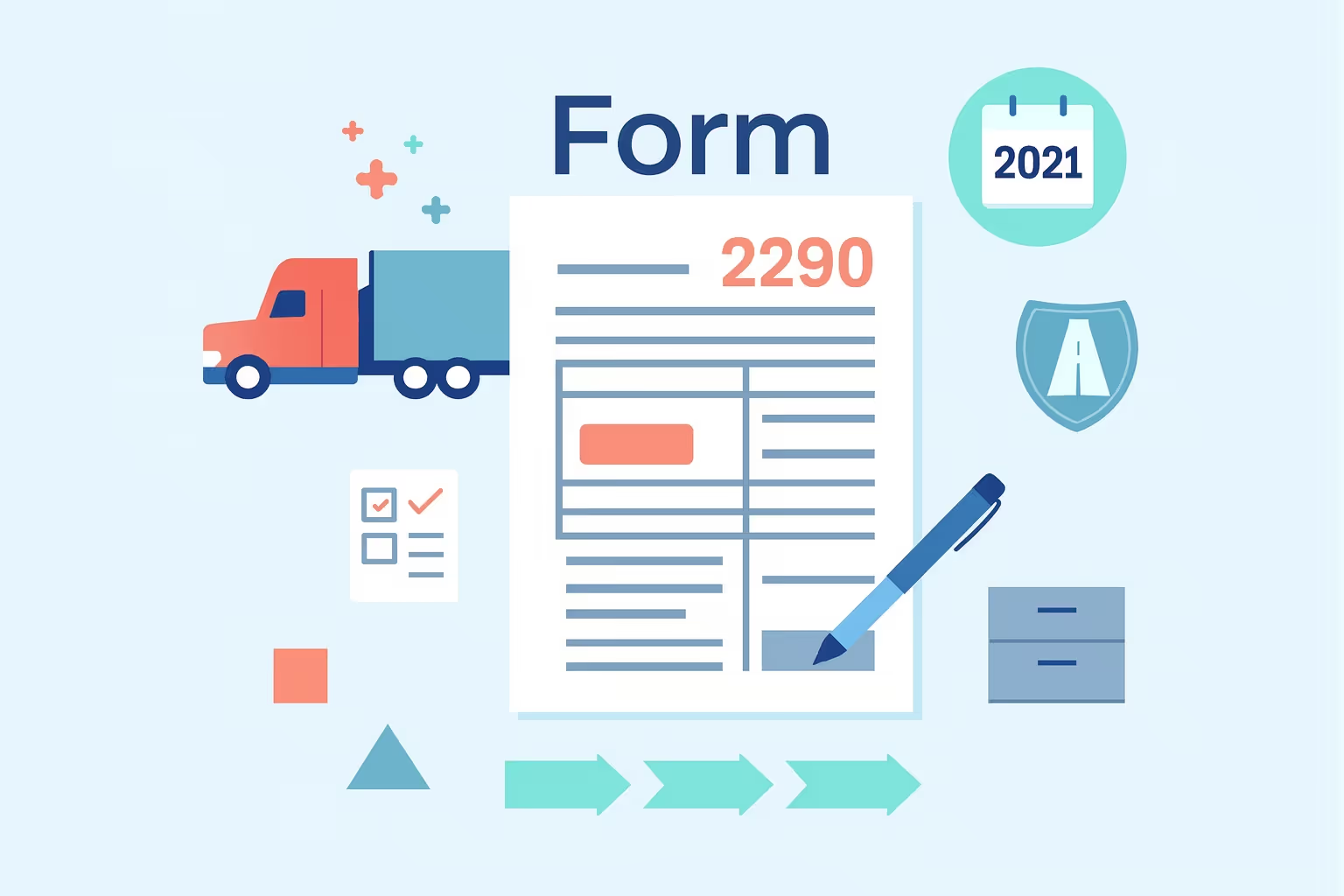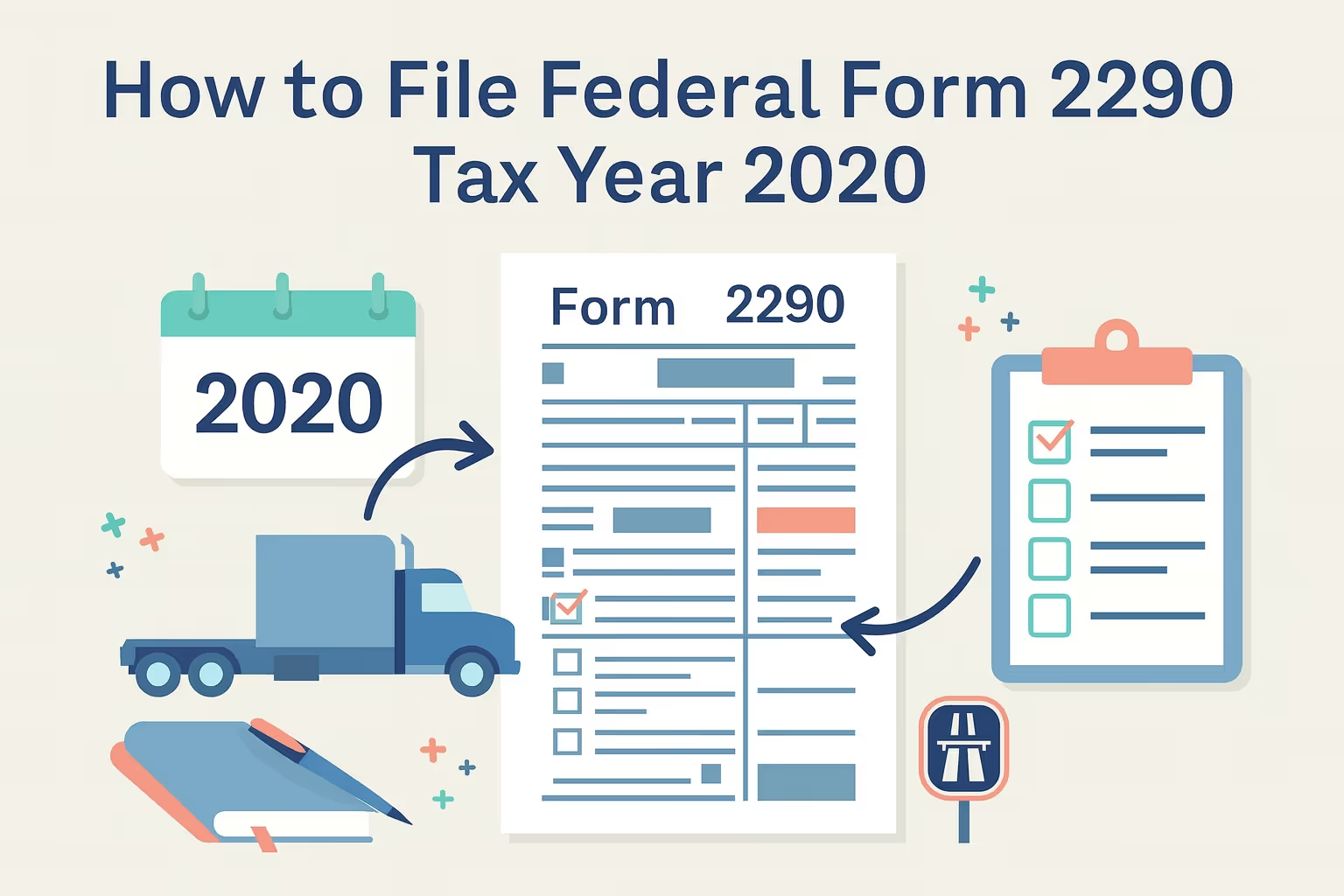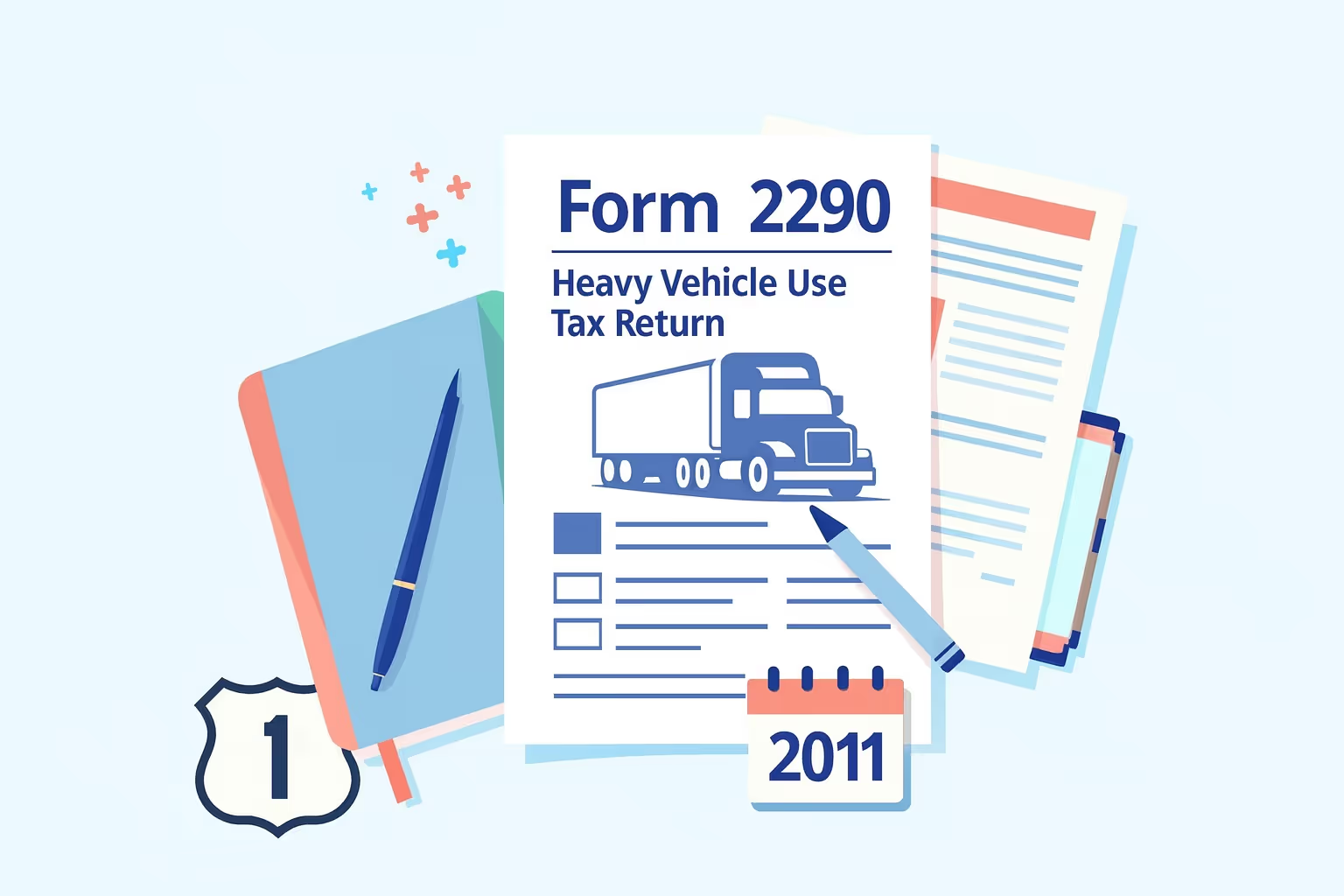Form 2290 2010 Instructions for Highway Vehicle Use Tax
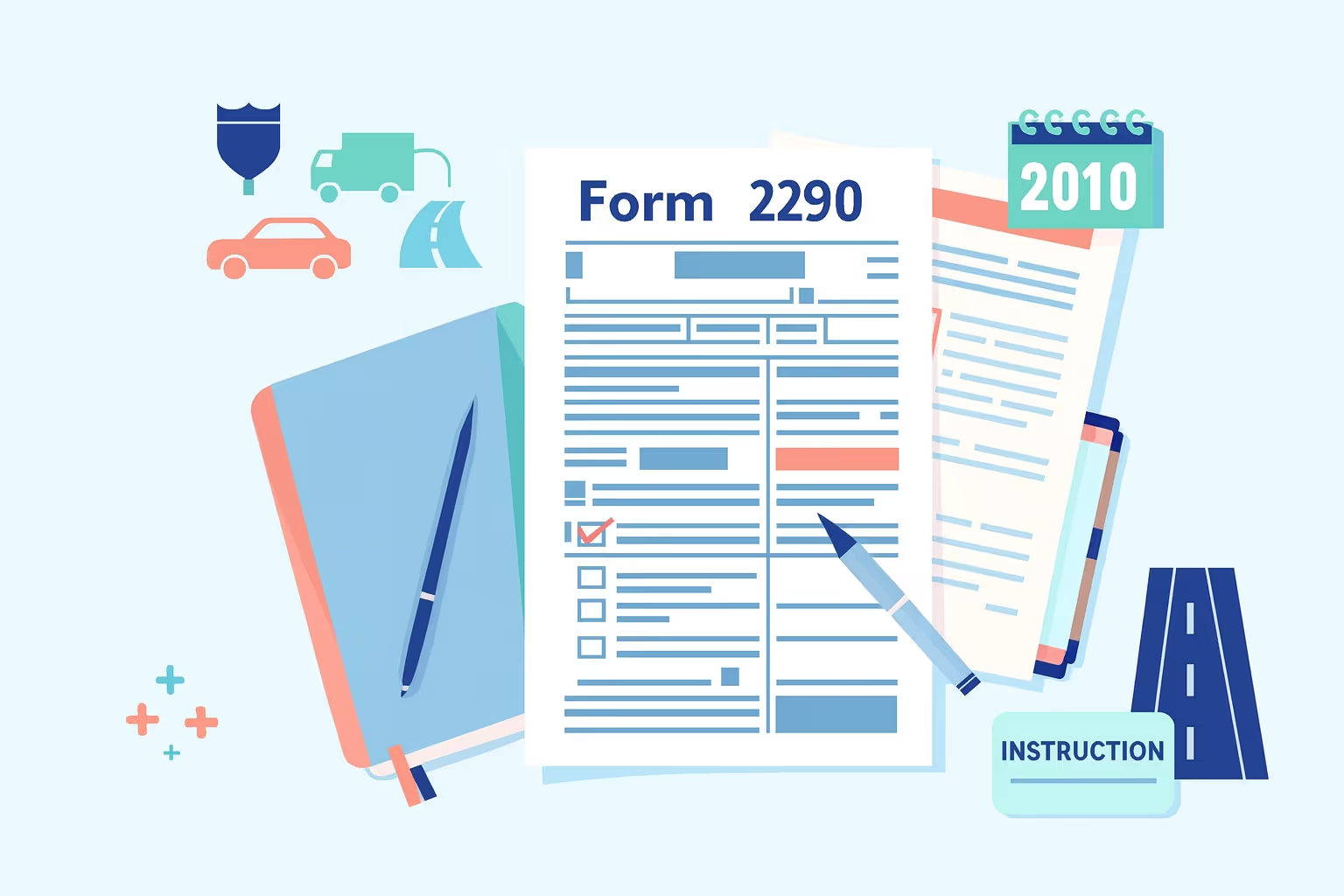
Owners and operators of highway motor vehicles weighing 55,000 pounds or more must file an annual vehicle use tax return under the federal excise tax program. The return is completed using IRS Form 2290, which applies to heavy vehicles operating on public highways. This filing ensures compliance with federal regulations and supports funding for essential transportation infrastructure nationwide.
The Heavy Vehicle Use Tax (HVUT) is an annual federal obligation that helps maintain and improve the nation’s roads. The federal government distributes revenues collected through HVUT into the Federal Highway Trust Fund, which finances highway construction, maintenance projects, and safety programs. Through this process, those who operate heavy vehicles and contribute most to roadway wear also support the upkeep of public infrastructure for all motorists.
Filers must prepare accurate vehicle details, including registered gross weights, first-use dates, and vehicle identification numbers, before submission. For the 2010 tax period, the official Form 2290 (Rev. July 2010) serves as the required tax form for calculating and paying the heavy vehicle use tax. Reviewing this form ensures that each filer accurately reports the Heavy Vehicle Use Tax and meets all applicable requirements.
Who Must File IRS Form 2290 Heavy Vehicle Use Tax Return
Individuals and businesses that operate highway motor vehicles must understand their obligations under the Heavy Vehicle Use Tax. The Internal Revenue Service requires every taxpayer who owns or operates heavy vehicles with a taxable gross weight of 55,000 pounds or more to file this annual return. Meeting these requirements ensures that each registered vehicle contributes its fair share to the federal excise tax program.
Filing Obligation
- The Heavy Vehicle Use Tax applies to any vehicle operated on public highways with a taxable gross weight of 55,000 pounds or more.
- Owners of such vehicles must file a vehicle use tax return for the period covering July 1, 2010, through June 30, 2011.
- The tax applies regardless of whether the vehicle is used for business, agriculture, or specialized transportation.
Entities Required to File
- Truck owners or fleet operators who have vehicles registered under their names are required to file.
- Partnerships, corporations, or limited liability companies that manage taxable vehicles must also submit the required filings.
- Qualified blood collector organizations operating specialized motor vehicles on public highways are likewise required to file.
Vehicle Classification
- Vehicles with a registered gross weight equal to or greater than 55,000 pounds are required to file an annual report.
- Agricultural vehicles are considered taxable if their use exceeds 7,500 miles during the tax period.
- Vehicles exempted from other federal excise taxes must still report their category for proper classification.
Required Identification Details
- A valid Employer Identification Number is mandatory; the IRS does not accept a Social Security Number for this filing.
- Each vehicle must include a verified Vehicle Identification Number that matches state registration records.
- Filers must confirm registered gross weights to determine accurate tax calculation and category placement.
Determining When a Vehicle Falls Under the Tax
- A vehicle becomes taxable once it begins operating on public highways during the filing period.
- Newly acquired taxable vehicles must be reported promptly to maintain compliance with federal reporting deadlines.
- Any vehicle increase in weight, category, or configuration that raises taxable gross weight requires an amended filing.
Taxpayers may use the Instructions for Form 2290 (Rev. July 2010) to confirm eligibility, vehicle categories, and reporting requirements. Understanding who must file helps prevent delays and ensures accurate payments to the federal government. Each eligible filer supports the Federal Highway Trust Fund, which finances maintenance projects and infrastructure improvements nationwide.
Preparing to File Your Heavy Vehicle Use Tax Return
Preparing an accurate Heavy Vehicle Use Tax Return requires organized records and verified details for each taxable vehicle. Filers must gather all necessary identification, ownership, and operational data before completing Form 2290 with the IRS. A thorough preparation process ensures compliance with federal excise tax rules and prevents common filing delays.
Gather All Key Details
Taxpayers must collect essential information before filing the vehicle use tax return. This includes the Employer Identification Number, Vehicle Identification Numbers, and the registered gross weights for every taxable vehicle. Each record must match the state’s vehicle registration data to avoid rejections or amended returns.
Owners must identify the month of first use for each highway motor vehicle operating on public highways. The IRS requires the precise entry of first-use dates to determine the appropriate filing period and calculate taxes. When vehicles exceed the mileage use limit, taxpayers must include a statement confirming their usage and the category of vehicle.
Confirm Vehicle Eligibility
Tax filers must verify that every motor vehicle meets the threshold for heavy vehicle classification. Any vehicle with a taxable gross weight of 55,000 pounds or more qualifies under the federal excise tax requirements. Vehicles registered for agricultural purposes remain eligible for reduced tax treatment only if their annual mileage is 7,500 miles during the tax period.
When a vehicle is acquired after the beginning of the tax year, the filer must determine whether it qualifies as a used taxable vehicle acquired from another taxpayer. If the previous owner has already paid the tax due for that period, the new owner may be eligible to claim a credit for the tax paid. This ensures that no duplicate payments are made for the exact vehicle and period.
Align Records Before Filing
Taxpayers should review all documents related to ownership, vehicle acquisition, and operating history before completing the form. The report must include acquisition details such as purchase dates, vehicle categories, and weight classifications. For newly acquired vehicles, filers must verify that registered gross weights equal the highest declared state registration weights.
Maintaining organized documentation supports an accurate tax return and future verification requests from the Internal Revenue Service. Records showing previous filings, credits claimed, or changes in vehicle configuration should remain accessible for a minimum of three years. A well-prepared filing process ensures that taxpayers can accurately calculate and pay the Heavy Vehicle Use Tax.
Step-by-Step Guide to Completing IRS Form 2290 Heavy Vehicle Use Tax
Completing IRS Form 2290 requires attention to detail and a full understanding of how each section determines tax liability. Taxpayers must ensure that every field accurately reflects the vehicle's data, the correct weight classifications, and valid identification numbers. Following these steps helps ensure proper filing, reduces errors, and supports the timely approval of the vehicle use tax return.
Step 1: Identify the First Use Month
Filers must begin by identifying the first month their heavy vehicle operated on public highways during the tax period. For the 2010 filing year, the tax period runs from July 1, 2010, through June 30, 2011. If the vehicle was first operated in July 2010, the first-use month should be recorded as “201007” in the proper field.
The first-use month determines both the reporting period and the amount of tax due under the federal excise tax program. Each taxable vehicle, whether new or previously owned, must list its actual month of first use to ensure compliance with Internal Revenue Service requirements.
Step 2: Determine the Taxable Gross Weight
Next, filers must calculate the taxable gross weight for each highway motor vehicle. The taxable gross weight includes the unloaded weight of the vehicle fully equipped for service, the weight of trailers customarily used with it, and the weight of the maximum load typically carried. Vehicles with a combined total of 55,000 pounds or more qualify for heavy vehicle tax reporting.
Any vehicle that increases in weight, such as through the addition of axles or attachments. If a vehicle’s registered gross weight equals higher limits declared for state registration, the exact figure must be reported on the tax return. Consistency between federal and state records prevents rejection or reassessment.
Step 3: Classify the Vehicle Category
IRS Form 2290 classifies vehicles into specific categories ranging from A through V, depending on taxable gross weight. Category W applies exclusively to suspended vehicles operating within the mileage use limit of 5,000 miles or less, or 7,500 miles during the tax period for agricultural vehicles. Each category has a corresponding tax rate listed in the Form 2290 Heavy Vehicle Use Tax Table.
Taxpayers must ensure that every taxable vehicle is classified under the correct weight category for accurate assessment and taxation. Vehicles operating under special exemptions or reduced rates must be clearly identified, along with supporting documentation if required.
Step 4: Complete Part I – Figure and Pay the Tax
In Part I, filers must figure and pay the total amount of heavy vehicle use tax owed. Begin with Line 1, entering the first-use date in the YYYYMM format. On Line 2, refer to the computation tables to determine the proper tax amount for each weight category. Multiply the number of vehicles in each category by the corresponding rate and enter totals in the appropriate columns.
Add the amounts to calculate the total tax for all vehicles. Filers claiming credits for vehicles destroyed, stolen, or sold during the period should record those adjustments on Line 5. Subtract credits from the total tax to determine the balance due, and record that figure on Line 6.
Step 5: Complete Part II – Suspension Statement
Part II applies to vehicles that qualify for suspension due to limited highway use. Taxpayers must complete the suspension statement for cars that will operate 5,000 miles or less during the tax period, or 7,500 miles for agricultural vehicles. Mark the appropriate box and list all qualifying vehicles under Category W.
If a vehicle exceeds the mileage use limit during the year, the taxpayer must file an amended return and pay the additional tax owed immediately. Accurate mileage records should support each suspension claim, including odometer logs or operational summaries, to substantiate the claim.
Step 6: Attach Schedule 1
Every filer must complete both copies of Schedule 1, listing all taxable and suspended vehicles, along with their corresponding Vehicle Identification Numbers. Schedule 1 serves as proof of filing and payment once stamped and returned by the Internal Revenue Service. Ensure each entry is accurate and matches data reported on the main form.
Taxpayers should retain one stamped copy for vehicle registration and for their records. Stamped Schedule 1 is also required to renew license plates and complete state registration renewals.
Step 7: Review Before Submission
Before submitting the return, taxpayers should carefully review each section for accuracy. Verify that each Employer Identification Number, Vehicle Identification Number, and gross weight entry is correct. Ensure that all destroyed, stolen, or sold vehicles are correctly recorded and credited.
A final review reduces the likelihood of delays or rejected filings. Submitting an accurate return allows the Internal Revenue Service to process payment promptly and issue a stamped Schedule 1 without interruption.
A precise and organized approach ensures compliance with federal law and the successful filing of IRS Form 2290. Each step contributes to accurate tax assessment, timely payment, and ongoing eligibility for vehicle registration under federal highway use tax regulations.
Filing and Payment Methods for Successful Filing
Filing the Heavy Vehicle Use Tax Return through IRS Form 2290 can be completed electronically or through traditional paper submission. Each filing method includes specific requirements based on the number of heavy vehicles reported during the tax period. Understanding these options ensures accurate reporting, timely processing, and proper submission of the return.
Electronic filing remains the preferred method for most taxpayers. It provides immediate confirmation, digital access to the stamped Schedule 1, and simplified payment options. Paper filing, while accepted for smaller fleets, requires additional preparation, mailing time, and verification steps.
Electronic Filing Overview
Electronic filing is mandatory for taxpayers reporting 25 or more heavy vehicles. The e-file system ensures efficient submission and reduces the likelihood of errors. It also allows filers to review entries before final submission and access stamped documents within 24 hours.
Taxpayers can complete the process through an IRS-approved electronic return originator. The system guides filers through each step, from uploading vehicle data to selecting a payment method. Electronic filing also supports faster resolution for amended returns or corrections during the tax period.
Benefits of Electronic Filing
- Electronic filing provides immediate confirmation of acceptance from the Internal Revenue Service.
- It grants quicker access to the stamped Schedule 1, which is required for vehicle registration.
- It lowers the error rate through digital form validation.
- It offers secure payment processing through verified IRS platforms.
- It supports easier tracking for multiple vehicles or large fleet submissions.
Paper Filing Overview
Paper filing is available for taxpayers reporting fewer than 25 vehicles. The process requires manual completion of IRS Form 2290 and Schedule 1, printing two copies of Schedule 1, and mailing them to the correct IRS address. Filers must include a payment voucher when submitting payment by check or money order.
To ensure timely processing, taxpayers must verify the accuracy of every field and sign the form before submitting it for mailing. Schedule 1 copies must match all reported vehicle information, including Vehicle Identification Numbers, taxable gross weights, and first-use months.
Checklist for Paper Filers
- Paper filers must complete and sign IRS Form 2290 in full.
- They should attach two copies of Schedule 1 listing all taxable and suspended vehicles.
- They must include Form 2290-V if paying through check or money order.
- The envelope must be addressed correctly based on the payment method.
- Taxpayers should retain proof of mailing along with copies of all submitted documents.
Payment Methods
Taxpayers can pay the tax due using one of three methods: Electronic Federal Tax Payment System (EFTPS), check or money order, or direct debit through e-file. The EFTPS provides a secure online payment option that allows direct payment from a bank account. Check and money order payments must include the Employer Identification Number, the phrase “Form 2290,” and the tax period on the memo line.
The IRS outlines official deadlines and accepted payment channels in the Forms 720, 2290, and 8849 Due Dates for Tax Year 2010. Adhering to the published schedule ensures all remittances align with federal tax reporting requirements and prevent avoidable processing delays.
Selecting the correct filing and payment method allows taxpayers to manage their compliance efficiently. Completing each step with accuracy and verification leads to a successful filing and smooth communication with the Internal Revenue Service.
Required Attachments and Recordkeeping for IRS Form 2290
Completing the Heavy Vehicle Use Tax Return requires more than filling out IRS Form 2290. Taxpayers must include all necessary attachments and maintain accurate documentation to validate each entry. Properly organized records support compliance with the Internal Revenue Service and facilitate future audits or inquiries related to the vehicle use tax return.
The following list outlines all documents and attachments required for a complete filing. Each item must reflect the same information reported on Form 2290 to ensure consistency and approval.
- Schedule 1 (Two Copies): Every filer must submit two identical copies of Schedule 1 listing all taxable and suspended vehicles. Once processed, the Internal Revenue Service will stamp and return one copy as proof of payment. The stamped Schedule 1 is required for vehicle registration, license renewals, and recordkeeping purposes.
- Consent to Disclosure: This form authorizes the IRS to share payment and filing data with state Departments of Motor Vehicles. Providing consent ensures that state agencies can confirm HVUT payment before issuing or renewing vehicle registrations. Missing this document may delay registration updates or result in processing hold requests.
- Credit Documentation: Taxpayers claiming a credit for tax paid on a used taxable vehicle acquired during the year must attach supporting proof. Documents must include the vehicle identification number, transaction date, and details of the previous owner. Credits are also available for vehicles that were destroyed, stolen, or sold during the tax period.
- Suspension Records: Filers claiming suspension must provide mileage logs and operational data supporting the claim. Records must demonstrate that each vehicle operated 5,000 miles or less, or 7,500 miles or less during the tax period if classified as agricultural. Evidence must include odometer readings, trip logs, and vehicle use summaries.
- Supporting Evidence for Adjustments: Any report of a vehicle increase in weight or configuration must include updated registration or state documentation. These attachments verify that the reported gross weight matches the current registered value and confirm the accurate placement of the tax category.
- Ownership and Acquisition Records: Taxpayers should retain documents related to each vehicle’s purchase or transfer, including bills of sale, titles, and acquisition reports. Keeping this information organized helps resolve questions about ownership or prior HVUT payments.
Maintaining complete records protects the taxpayer in the event of an IRS examination or dispute. Organized attachments also streamline renewals, credit claims, and amended filings for future tax periods. A complete and verified documentation package ensures the filing remains accurate, defensible, and compliant with federal highway use tax regulations.
Common Errors That Delay IRS Form 2290 Processing
Filing IRS Form 2290 requires precision across all sections to avoid delays and ensure timely acceptance. Minor errors can cause rejected submissions, delayed stamped Schedule 1 copies, or clarification requests from the Internal Revenue Service. Reviewing the most common mistakes helps taxpayers improve accuracy and maintain compliance with federal reporting standards.
- Filers must enter a valid Employer Identification Number matching IRS records and ensure each Vehicle Identification Number is accurate and consistent with the state registration to prevent mismatched data and delays.
- Taxpayers must report for the correct filing period, covering July 1, 2010, through June 30, 2011, and select the accurate weight category with registered gross weights that match the state registration values to confirm proper classification.
- Filers must include both copies of Schedule 1 and complete consent forms, and they must attach verified records supporting credit or suspension claims to prevent rejections caused by incomplete documentation.
- Taxpayers must amend their returns whenever a vehicle's weight, category, or configuration changes, as failing to report these changes can result in underreported liability and processing delays.
Completing a detailed review before submission helps prevent errors and supports compliance with IRS filing standards. Submitting accurate details and all required attachments ensures the stamped Schedule 1 is issued promptly and accepted without delay.
Exceptional Cases: Suspended, Agricultural, and Zero-Activity Filings
Some taxpayers qualify for exceptional filing circumstances based on how their heavy vehicles operate during the tax period. These exceptions apply to cars with limited mileage, vehicles used for agricultural purposes, or vehicles with no taxable activity. Understanding each scenario ensures proper reporting and compliance with Heavy Vehicle Use Tax requirements.
Suspended Vehicles
- Taxpayers may claim suspension for vehicles operating 5,000 miles or less on public highways during the tax period.
- Each suspended vehicle must be listed under Category W on Schedule 1, accompanied by mileage logs that verify limited use.
- Filers must maintain detailed records, including odometer readings and trip logs, to confirm that the mileage use limit has not been exceeded.
Agricultural Vehicles
- Agricultural vehicles qualify for suspension when they operate 7,500 miles during the tax period.
- The vehicle must be registered under an agricultural classification and used primarily for farming or transporting farm commodities.
- Mileage records should separate farm-related travel from public highway miles to verify eligibility for reduced tax liability.
Zero-Activity Filings
- Taxpayers who did not operate any taxable vehicles during the period from July 1, 2010, through June 30, 2011, are not required to file Form 2290.
- Filers must maintain documentation showing no taxable vehicle ownership or use for audit purposes.
- Businesses ending operations or disposing of all vehicles must mark the “Final Return” box on Form 2290 and submit a completed filing.
Applying the correct classification ensures accurate reporting, prevents unnecessary taxes, and supports compliance with federal HVUT regulations. Correctly identifying vehicle categories also helps taxpayers avoid amendments, late notices, and avoidable payment disputes.
Frequently Asked Questions
What qualifies as a heavy highway vehicle under the federal tax program?
A heavy highway vehicle is any truck, tractor, or bus registered and operated on public highways with a taxable gross weight of 55,000 pounds or more. The federal Internal Revenue Service defines taxable gross weight as the combined weight of a vehicle, trailers, and the maximum load customarily carried. These vehicles must file annually through IRS Form 2290 to contribute to the annual federal highway fund that supports infrastructure maintenance.
How does the IRS define heavy highway vehicle use for filing purposes?
Heavy highway vehicle use applies to vehicles operating on public highways during the tax period. The period the taxable gross weight applies runs from July 1 through June 30 of the following year. Filers must record the first use month on the tax form to determine when liability begins. Vehicles exceeding limited mileage thresholds are considered taxable and must be reported through the heavy vehicle tax return.
How does e-filing simplify IRS Form 2290 submission?
E-filing provides an efficient way for taxpayers to complete and submit the heavy highway vehicle tax return online. Through easy-to-use e-platforms approved on the IRS website, filers can enter all vehicle details, verify calculations, and pay taxes electronically. This process reduces errors, shortens processing time, and allows faster access to the stamped Schedule 1 needed for vehicle registration. Electronic filing also offers immediate confirmation and secure record storage.
What if a new vehicle is purchased during the tax year?
When a taxpayer acquires a new vehicle, the filing requirement begins in the month the car first operates on public highways. The owner must calculate the tax based on the period during which the taxable gross weight applies and report it on IRS Form 2290. Taxpayers should retain purchase records and payment confirmations to verify compliance with the federal Internal Revenue Service during audits or when renewing registrations.
Can credits apply to tax paid on vehicles no longer in service?
Taxpayers may claim credit for tax paid on vehicles that are destroyed, stolen, sold, or used below the required mileage. The credit applies when the car is no longer subject to the Heavy Vehicle Use Tax within the same period. Supporting documentation must confirm that the vehicle was destroyed, stolen, or sold before filing the claim. The IRS requires full evidence of the transaction or loss for proper verification.
What is the mileage limit for agricultural vehicles under HVUT?
Agricultural vehicles operating exclusively for farming may qualify for suspension if they travel 7,500 miles or less on public highways during the tax period. These vehicles must be registered in an agricultural classification and used primarily to transport farm goods. Farmers must keep accurate mileage logs to verify that each unit remains within the 7,500-mile threshold set under heavy highway vehicle use regulations.
Where can taxpayers find detailed instructions for completing Form 2290 with the IRS?
Taxpayers can access detailed instructions for preparing and submitting Form 2290 on the IRS website. The publication provides line-by-line guidance on reporting the weight of a vehicle, recording the month of first use, and calculating the tax owed. Reviewing the official resource ensures accuracy, compliance with filing deadlines, and proper documentation for the annual federal highway program. Filers should always reference the current version to ensure compliance with reporting requirements.
















